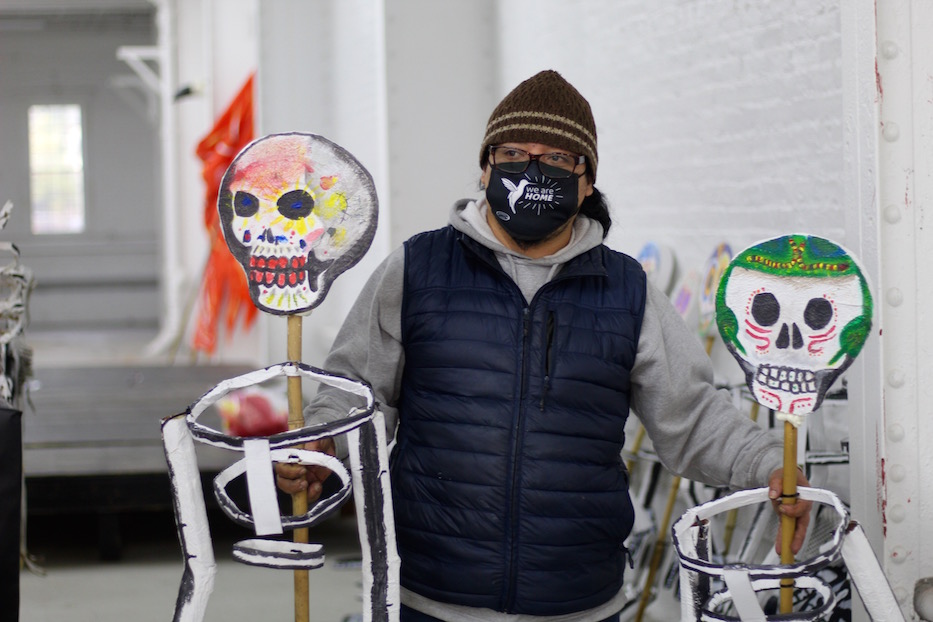
Dia de los Muertos | Arts & Culture | Unidad Latina en Acción | Visual Arts | Puppetry
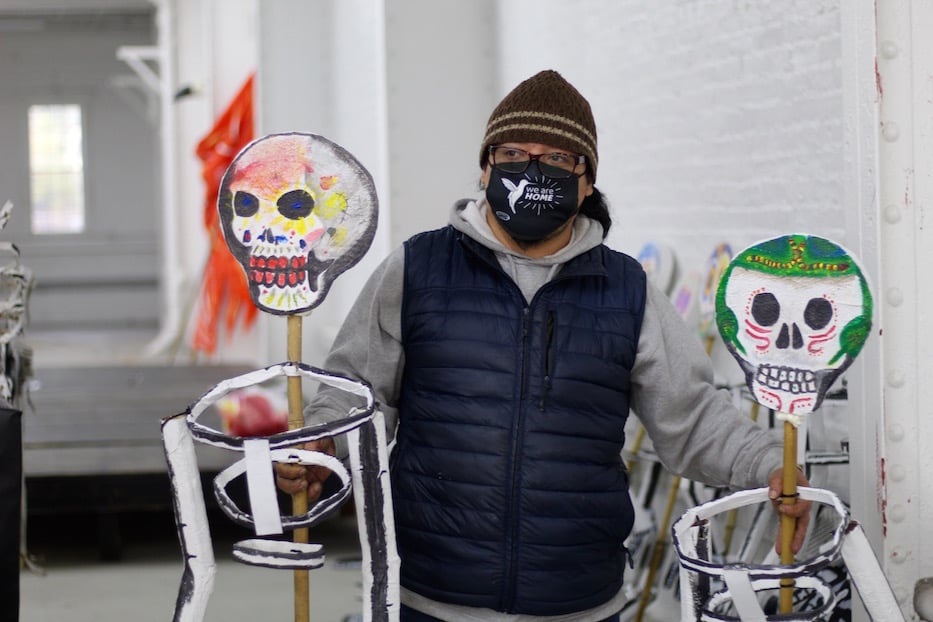
Guatemalan artist Pedro Lopez, who has returned for three months as ULA's artist in residence. Lucy Gellman Photos.
In a Mill Street warehouse, Nero the dog leaned forward on his skeletal paws, his ribcage covered in a delicate coat of blue and red flowers. One room away, a ghost train snaked through the open space, sprouting crepe paper marigolds and dahlias from its windows. Mother Earth extended her bony arms, a crown of green ivy dripping from her forehead.
Twenty-two painted skeletons looked out into the room beside her, each memorializing a New Havener lost to gun violence this year.
The scene has become a familiar one for Guatemalan artist Pedro Lopez, who returned to New Haven this fall for Unidad Latina en Acción’s (ULA) annual Día de Muertos parade. In advance of the Nov. 6 event, Lopez and organizer Tamara Nuñez del Prado have held nightly art workshops at a Mill Street warehouse, now filled with cardboard, bamboo, and Papier-mâché puppets. Saturday, the parade will pay homage to 23 victims of gun violence that the city has lost this year.
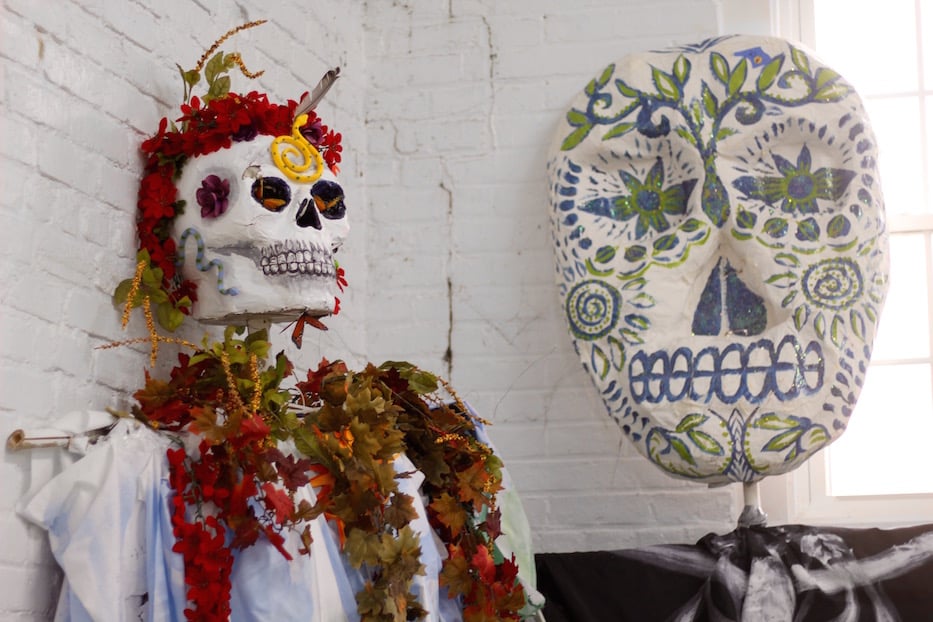
Mother Earth will return this year.
“Through art, through color, we can touch on themes that are very sensitive,” Lopez said in Spanish, as ULA member Megan Fountain translated. “It's a way to reach from the youngest child to the eldest person in our community. We can touch on sensitive issues, but not in a cold way, the way it's portrayed in the news. Through art, we can create consciousness about what's happening.”
Lopez’ work began long before November. Weeks ago, members of ULA started planning the theme, which in past years has included border crossing, climate preservation, partner violence and most recently the deadly Covid-19 pandemic. The artist, whose work champions Indigenous rights and climate sovereignty in Guatemala, said he sees the line from gun violence to systemic racism and state-sanctioned violence, all of which work to oppress people of color. As he spoke, two of his barriletes gigantes—huge, vibrant kites that commemorate the dead—peeked out from across the room.
In late October, he invited members of ULA and the wider New Haven community to build and decorate the skeletons with him. In an effort to be kind to the planet, he said, everything is recycled—including puppets from years past that may need a new coat of paint or repaired limbs. The skeletons are no exception, made from recycled cardboard and bamboo.
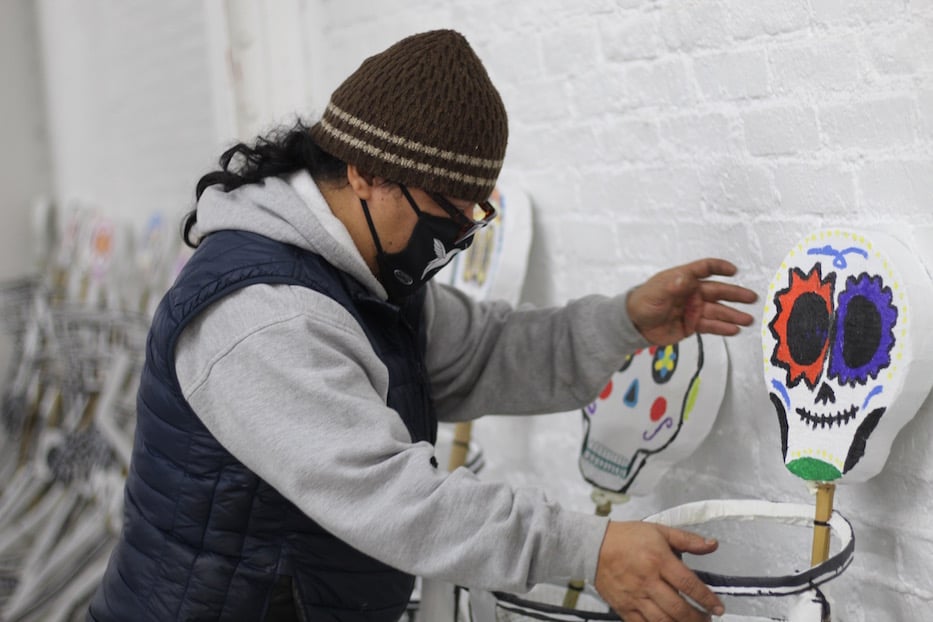
Propped up against walls, they now stare wide-eyed into the room, their weathered teeth visible and pressed tightly together as if they are chattering. No one puppet is the same: one sports butter-yellow sunflowers where its eyes should be. Another is outlined in thick, verdant green, with stripes of red etched across its chin and cheeks. Others sport sinuous lines, geometric shapes, and faces adorned with generous circles of rouge. Some smile, their lips sewn into one tight line for eternity.
When they dance through the streets of Fair Haven on Saturday, Lopez is hopeful that viewers will think about the toll that each of those deaths take. He picked up two, their limbs suddenly dangling. As he did, Nuñez del Prado pointed to the disparity in coverage and attention that she sees between high-profile murder cases and poor city residents who have been shot and killed.
“There's a question about why many of these murders have gone uninvestigated and unsolved by the authorities,” Lopez said. “Many of the victims are Latino, or they're African-American. They might be undocumented immigrants … If we look at the economy and the data, the immigrant labor force holds up the economy and moves the economy here. But immigrants are not treated as lives that matter.”
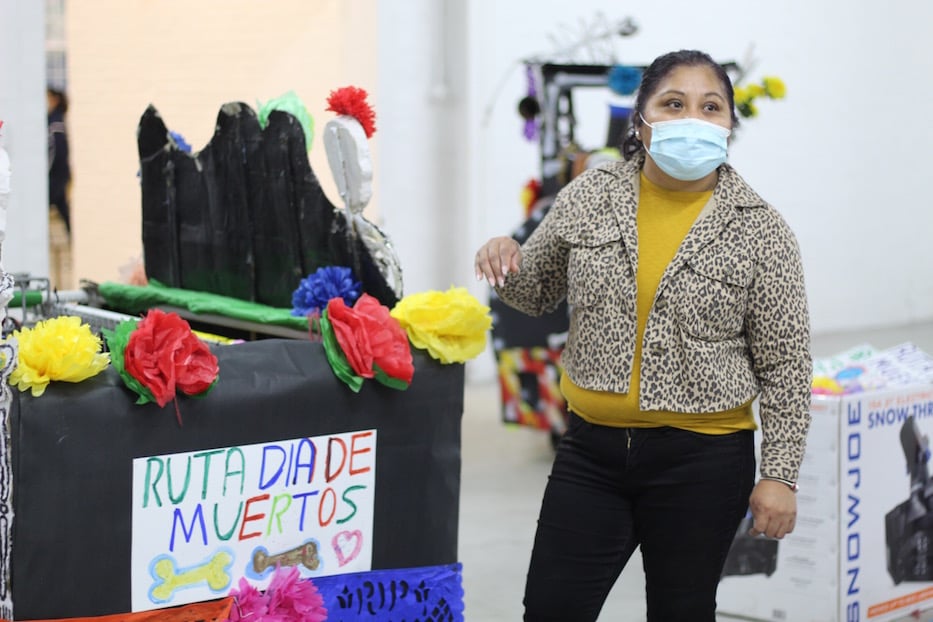
Juana Valle, who discovered ULA during the early days of the pandemic.
In the center of the room, half a dozen participants fastened paper flags and flowers to a spectral version of La Bestia, the freight train atop which hundreds of thousands of migrants cross Mexico each year. After starting at the Mexico-Guatemala border, the train heads north, traveling from Chiapas to Oaxaca to Veracruz to Lechería, and on to forked destinations at the U.S.-Mexico border. When they climb aboard, migrants know that they are risking both their physical safety and their lives. Many, fleeing famine, environmental disaster, and years of violence in their home countries, make the trek anyway.
Juana Valle, who discovered ULA during the early days of the pandemic, moved train cars into a line with fellow volunteers. Last year, she turned to the organization as waves of unemployment and food insecurity tore through New Haven. Valle cares for her four children, who were suddenly home. She found an organization that offered her help, and came to decorate as a way to give back.
Born and raised in Acatlán de Osorio in Puebla, Mexico, Valle grew up observing Día de Muertos with her family. When she was a child, her family taught her how to make an ofrenda, the altar that honors the dead with fruit, flowers, drinks, and sweet bread called pan de muerto.
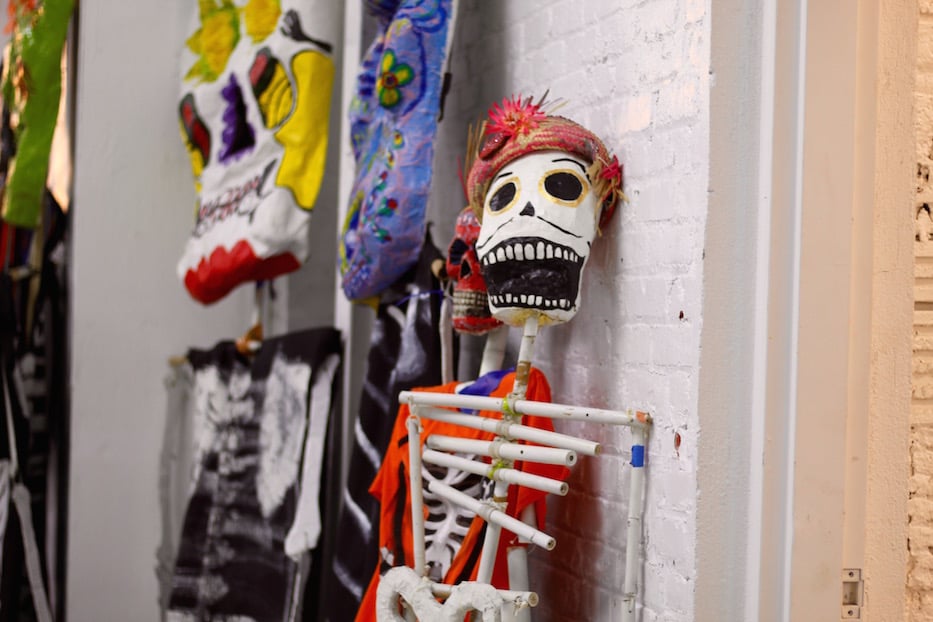
She still makes space in her home today, she said as the wheels beneath the cars—converted shopping carts with painted cardboard boxes—squeaked and rattled on the floor. On her ofrenda this year, she will have food and beer waiting for her father, who died 27 years ago, as well as her grandparents, several aunts and uncles, and most recently her dog, who passed away just two weeks ago.
“When our family members die, when they leave us, November is the time we take to remember them,” she said as Fountain translated. “In our belief, even if we don’t see them physically, as long as we keep their memory alive, they stay with us forever.”
As a Fair Havener and a mother herself, Valle said that the theme of gun violence resonates with her this year. In the neighborhood, “one is always very afraid,” she said. Two years ago, her brother was assaulted in the driveway of their home while returning from a late night shift. “One calls the police,” she said, “but the police do nothing.”
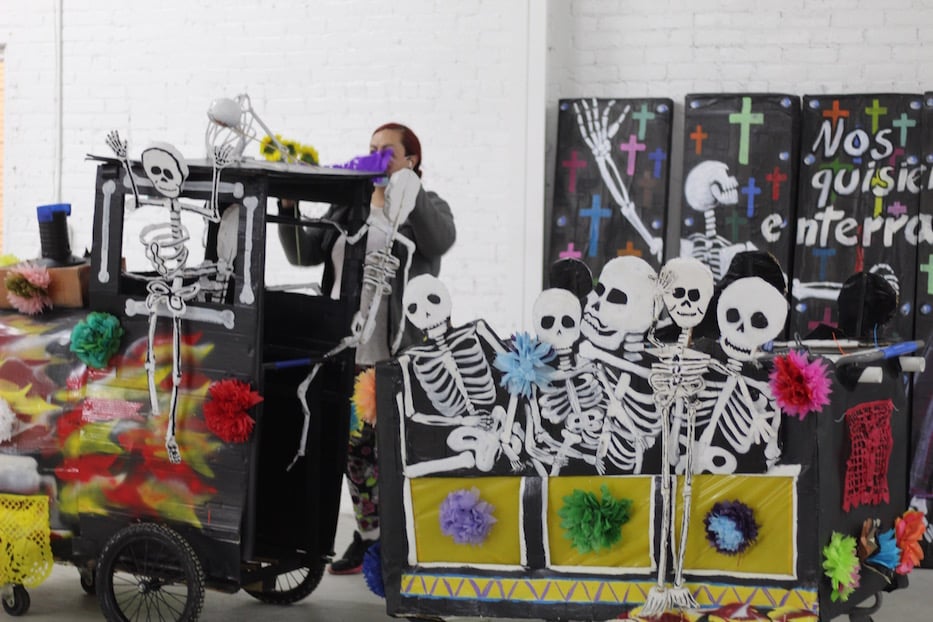
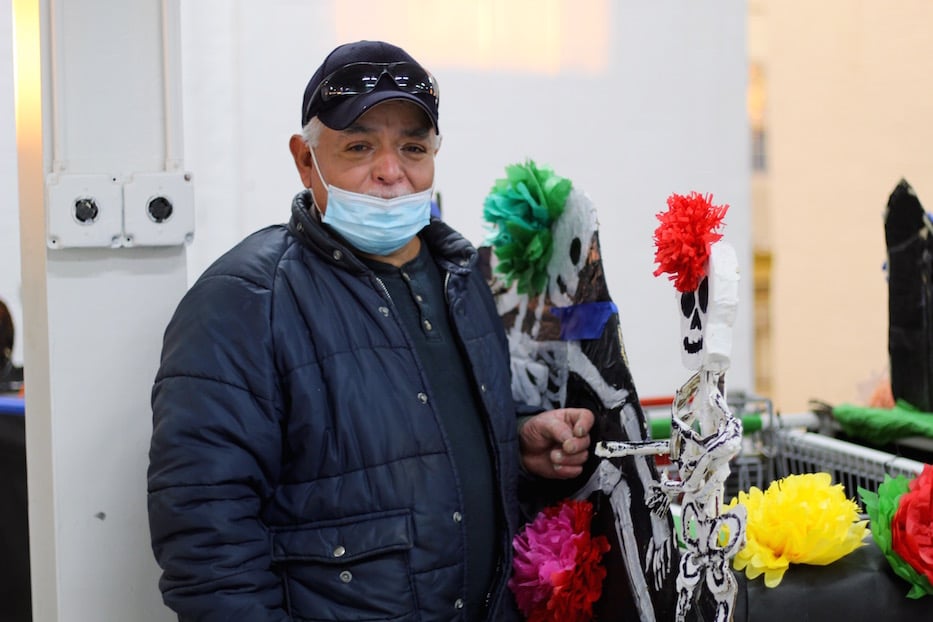
Top: Tamara Nuñez del Prado works on La Bestia. Bottom: Felipe Romero.
As he inspected two passengers clasping their bony hands, Felipe Romero recited La Bestia’s path northward, as if charting its course out loud might make the journey safer for those still aboard, or considering the voyage.
He smoothed a ream of black construction paper and described the risk of injury and death, recounting stories of lives lost and limbs snapped in two. By the time some migrants reach the train, many of them have already travelled hundreds of miles from home in Central America.
Fourteen years ago, Romero came to New Haven from Puebla, Mexico. By day, he works for a landscaping company. This week, he has dedicated his nights to parade prep for the first time. He said that it connects him to a tradition that is centuries old.
“Our grandparents, our parents—it’s something that we pass on from year to year,” he said. Growing up, his family celebrated one day specifically for children who had died, another for victims of accidents, and a third for all those who had died. “It’s a very historic tradition.”
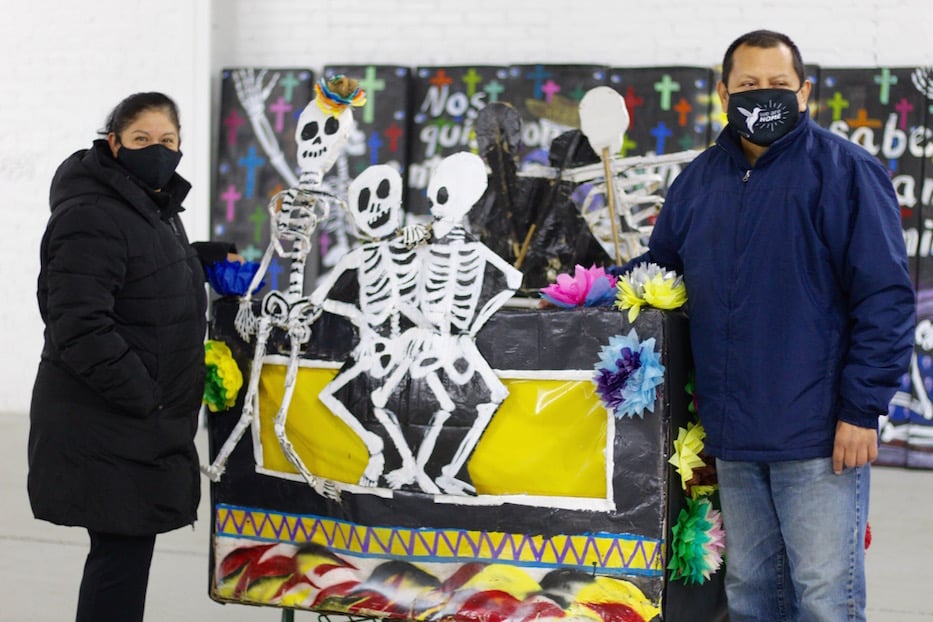
ULA members Araceli Sartillo and Israel Espejel.
A steady stream of volunteers trickled in as people got off their shifts for the day. Some gravitated towards tables, where they could pick up a brush and work on a puppet in peace. Others brought pint-sized visitors that slept on their backs or ran around the room, giggling as they dodged cardboard bones and ogled freight cars covered in skeletons.
From behind a mask printed with a hummingbird and the words “We Are Home,” ULA member Israel Espejel wove immigration reform into the night’s conversations. Before the pandemic, Espejel was working two jobs to support himself and his family. When both of them laid him off last year, the stress of unemployment caused him to get sick. A stroke last year left him blind in one eye. Unable to work, he found ULA and started attending activist meetings.
Thursday, he was buoyed by the news that the Build Back Better agenda now includes new language around immigration reform. This week, the House of Representatives added provisions that would allow immigrants who entered the United States before Jan. 1, 2011 to seek work permits for five years. In September, a proposal to create an easier path to citizenship for undocumented immigrants was struck from the plan entirely.
“This is a reduced version of what we wanted,” he said. “But we need to fight.”
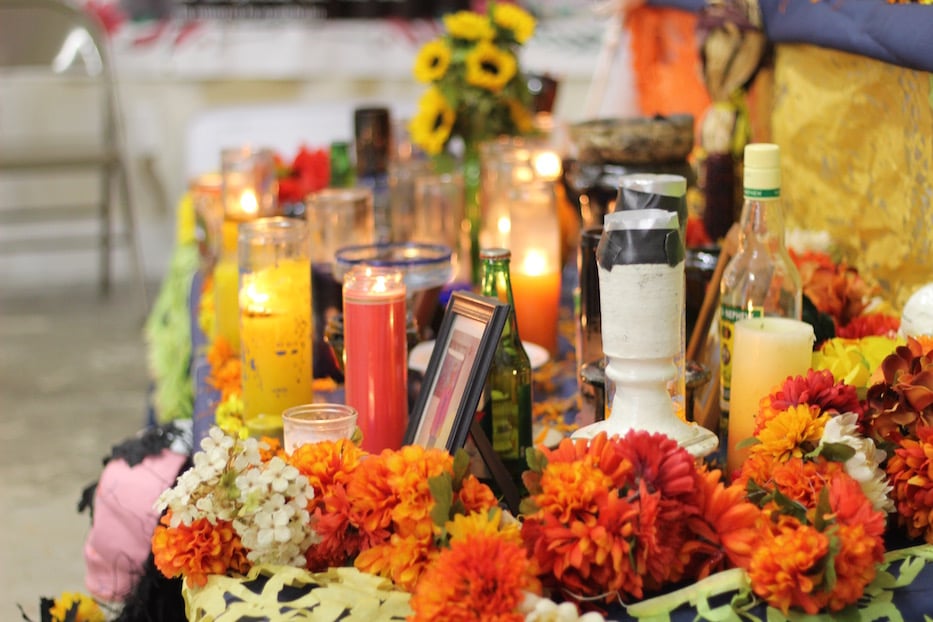
Closer to the building’s entrance, candles flickered on top of a volunteer ofrenda, its tiers lined with fresh and fabric flowers, bottles of beer and tequila, and dozens of family photographs. An infant’s face caught in the light as the Virgin of Guadalupe stood watch beside it. A ceramic vase of cut sunflowers had started to droop nearby. School-aged kids and elders alike looked back, their smiles huge and full of light. A faded image at the bottom showed the Mexican artist Frida Kahlo surrounded by people, her gaze catching the camera.
At the top of the altar, the face of the late New Havener Maria Pabón beamed from its frame. During her life in New Haven, Pabón—herself Puerto Rican—forged strong ties with the immigrant and activist community in Fair Haven. She died suddenly last year, in the first months of the pandemic. A poem written in her honor sprawled across the wall beside the ofrenda. Two strings of paper flags hung brightly overhead.
Maria siempre ayudando/A nuestros amigos inmigrantes, it read.
Pero la flaca siempre/Buscando a quien llevarse antes
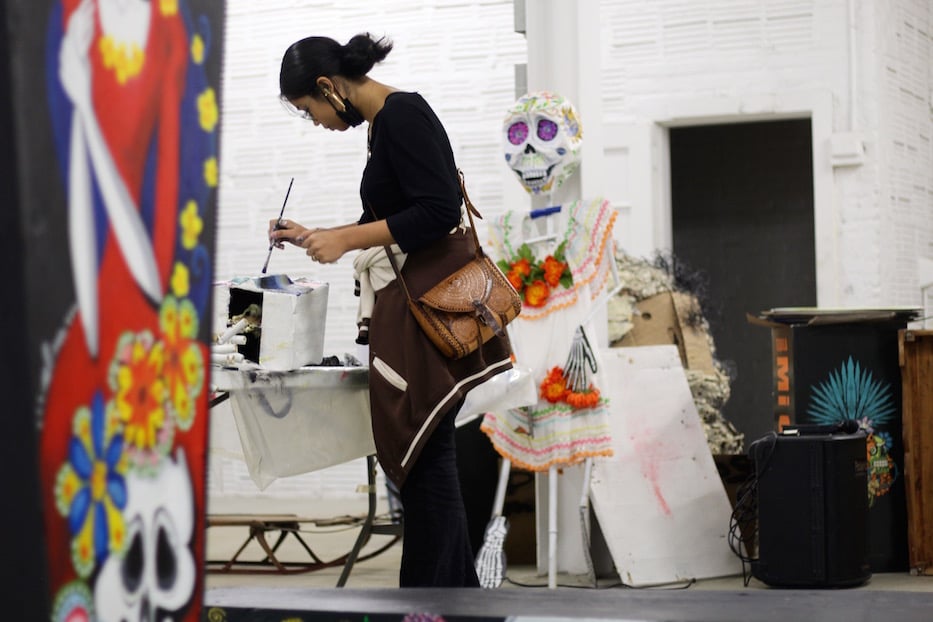
“Internationally this week, the dead are what connect us all,” said CJ, the founder and director of Black and Brown United in Action. Originally from Trinidad and Tobago, she and her children celebrate Diwali this time of year. She pointed to a range of global traditions around light and celebration this time of year, from Día de Muertos to All Saints’ Day to Diwali. It helps her grieve, she said she is in mourning after putting her dog to sleep on Monday. Back home, her aunt has been visiting the graves of deceased family members.
“It’s amazing,” she said, looking over the ofrenda. She fished an extra votive candle out of her bag for Fountain, who had wondered aloud whether there was time to add a picture in remembrance of her grandmother.
For some, the parade prep also marked a full-circle moment. After coming to the U.S. from Toluca, Mexico with his wife in 2001, Jose Armas became one of the earliest members of ULA. He fought alongside ULA Co-Founder John Lugo and Kica Matos for the Elm City Resident I.D. Card, which became available in July 2007. As Armas’ kids grew up, he stepped away from the group to raise his family. This week, he returned grateful to lend a hand.
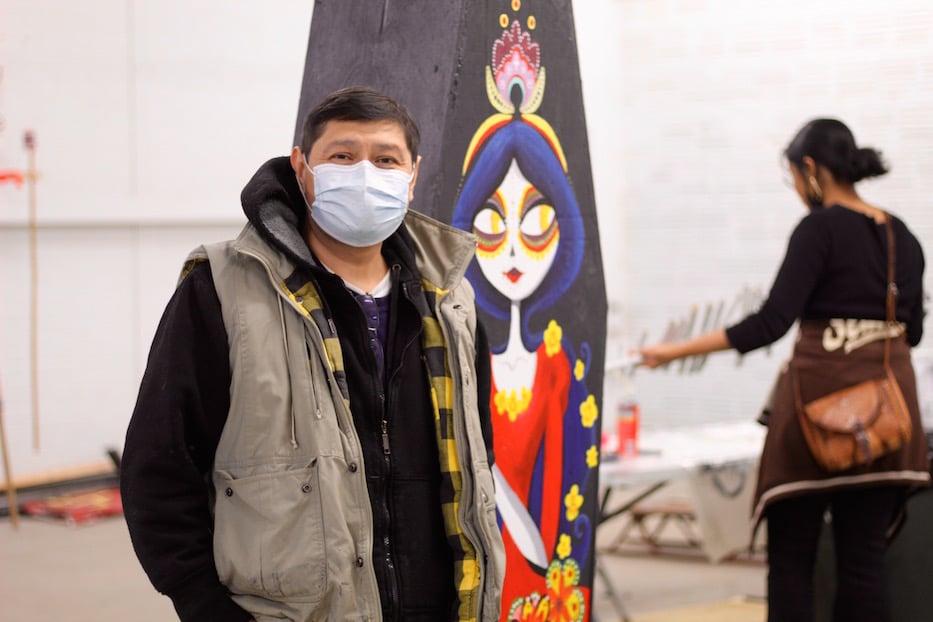
Jose Armas. He stressed how hard it is for immigrants to find community when they are far from home.
He said that Día de Muertos is especially meaningful to him this year. Well before his birth, his father and grandparents lived in a cemetery. They were poor, he said; it was where they could find shelter. At just nine years old, his dad began working for a woman who eventually paid him in land. He and Armas’ mother were able to build on that land and have a life together. Five years ago, she passed away. Armas, thousands of miles away, was unable to make it home.
“I could not do anything,” he said. He felt powerless. Each year, the ofrenda—piled with bread, fruit, and tequila for his grandparents and mother—helps him cope with that sense of loss.
Further back in the warehouse, Lopez moved onto the large black-and-white face of a puppet, lifting it high as he carried it from one table to the other. He said he plans to continue using art as a vehicle for social justice work after the parade, during a residency with ULA in New Haven.
In particular, he is designing a series of multimedia workshops that bring in members of the community and “celebrate the traditional lifeways of Indigenous peoples,” he said. He is hoping to form an artists’ collective by the group’s 20th anniversary in 2023, he said.
“There are various artists who are always collaborating,” he said. “We think that they have a lot to offer in terms of their talent and their time.”

